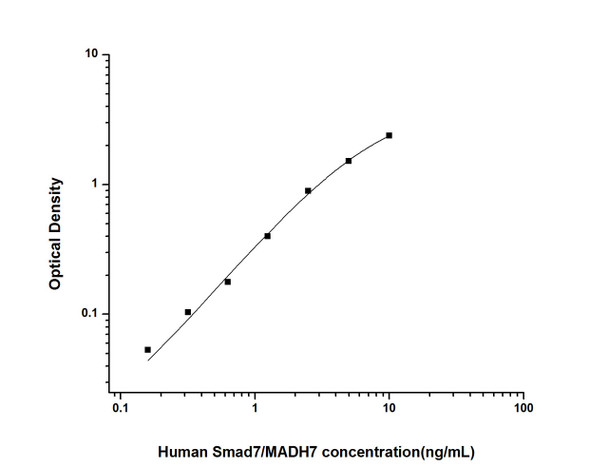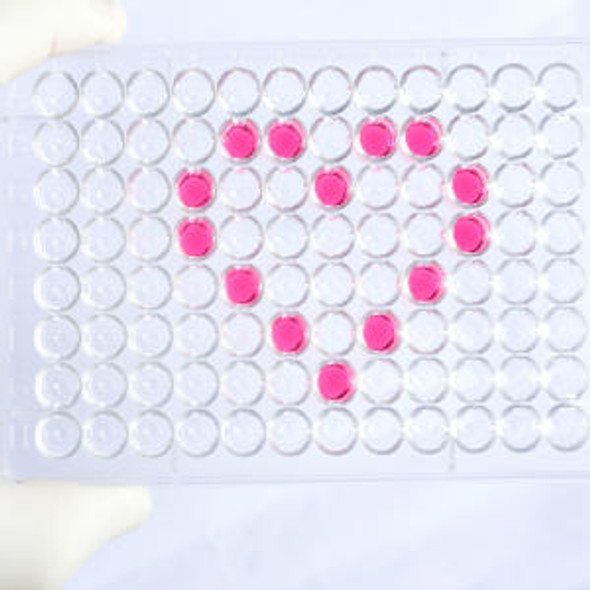Human Epigenetics and Nuclear Signaling ELISA Kits
Human Smad7/MADH7 (Mothers Against Decapentaplegic Homolog 7) ELISA Kit (HUES02058)
- SKU:
- HUES02058
- Product Type:
- ELISA Kit
- Size:
- 96 Assays
- Uniprot:
- O15105
- Sensitivity:
- 0.09ng/mL
- Range:
- 0.16-10ng/mL
- ELISA Type:
- Sandwich
- Reactivity:
- Human
- Sample Type:
- Serum, plasma and other biological fluids
- Research Area:
- Epigenetics and Nuclear Signaling
Description
| Assay type: | Sandwich |
| Format: | 96T |
| Assay time: | 4.5h |
| Reactivity: | Human |
| Detection Method: | Colormetric |
| Detection Range: | 0.16-10 ng/mL |
| Sensitivity: | 0.10 ng/mL |
| Sample Volume Required Per Well: | 100µL |
| Sample Type: | Serum, plasma and other biological fluids |
| Specificity: | This kit recognizes Human Smad7/MADH7 in samples. No significant cross-reactivity or interference between Human Smad7/MADH7 and analogues was observed. |
This ELISA kit uses Sandwich-ELISA as the method. The micro ELISA plate provided in this kit has been pre-coated with an antibody specific to Human Smad7/MADH7. Standards or samples are added to the appropriate micro ELISA plate wells and combined with the specific antibody. Then a biotinylated detection antibody specific for Human Smad7/MADH7 and Avidin-Horseradish Peroxidase (HRP) conjugate are added to each micro plate well successively and incubated. Free components are washed away. The substrate solution is added to each well. Only those wells that contain Human Smad7/MADH7, biotinylated detection antibody and Avidin-HRP conjugate will appear blue in color. The enzyme-substrate reaction is terminated by adding Stop Solution and the color turns yellow. The optical density (OD) is measured spectrophotometrically at a wavelength of 450 nm ± 2 nm. The OD value is proportional to the concentration of Human Smad7/MADH7. The concentration of Human Smad7/MADH7 in samples can be calculated by comparing the OD of the samples to the standard curve.
| UniProt Protein Function: | SMAD7: Antagonist of signaling by TGF-beta (transforming growth factor) type 1 receptor superfamily members; has been shown to inhibit TGF-beta (Transforming growth factor) and activin signaling by associating with their receptors thus preventing SMAD2 access. Functions as an adapter to recruit SMURF2 to the TGF-beta receptor complex. Also acts by recruiting the PPP1R15A- PP1 complex to TGFBR1, which promotes its dephosphorylation. Positively regulates PDPK1 kinase activity by stimulating its dissociation from the 14-3-3 protein YWHAQ which acts as a negative regulator. Genetic variations in SMAD7 influence susceptibility to colorectal cancer type 3 (CRCS3). Colorectal cancer consists of tumors or cancer of either the colon or rectum or both. Cancers of the large intestine are the second most common form of cancer found in males and females. Symptoms include rectal bleeding, occult blood in stools, bowel obstruction and weight loss. Treatment is based largely on the extent of cancer penetration into the intestinal wall. Surgical cures are possible if the malignancy is confined to the intestine. Risk can be reduced when following a diet which is low in fat and high in fiber. Belongs to the dwarfin/SMAD family. |
| UniProt Protein Details: | Protein type:Transcription factor; DNA-binding Chromosomal Location of Human Ortholog: 18q21. 1 Cellular Component: nucleoplasm; transcription factor complex; protein complex; cell-cell adherens junction; cytoplasm; plasma membrane; catenin complex; cytosol; nucleus Molecular Function:collagen binding; protein binding; metal ion binding; ubiquitin protein ligase binding; beta-catenin binding; activin binding; transforming growth factor beta receptor, inhibitory cytoplasmic mediator activity; transcription factor activity Biological Process: transcription initiation from RNA polymerase II promoter; protein stabilization; transcription, DNA-dependent; negative regulation of transcription factor activity; negative regulation of peptidyl-serine phosphorylation; negative regulation of transcription from RNA polymerase II promoter; regulation of activin receptor signaling pathway; negative regulation of BMP signaling pathway; BMP signaling pathway; regulation of transforming growth factor beta receptor signaling pathway; ureteric bud development; positive regulation of protein ubiquitination; positive regulation of proteasomal ubiquitin-dependent protein catabolic process; transforming growth factor beta receptor signaling pathway; positive regulation of cell-cell adhesion; negative regulation of ubiquitin-protein ligase activity; artery morphogenesis; ventricular cardiac muscle morphogenesis; positive regulation of transcription from RNA polymerase II promoter; negative regulation of protein ubiquitination; gene expression; negative regulation of transforming growth factor beta receptor signaling pathway; negative regulation of cell migration Disease: Colorectal Cancer, Susceptibility To, 3 |
| NCBI Summary: | The protein encoded by this gene is a nuclear protein that binds the E3 ubiquitin ligase SMURF2. Upon binding, this complex translocates to the cytoplasm, where it interacts with TGF-beta receptor type-1 (TGFBR1), leading to the degradation of both the encoded protein and TGFBR1. Expression of this gene is induced by TGFBR1. Variations in this gene are a cause of susceptibility to colorectal cancer type 3 (CRCS3). Several transcript variants encoding different isoforms have been found for this gene. [provided by RefSeq] |
| UniProt Code: | O15105 |
| NCBI GenInfo Identifier: | 18418630 |
| NCBI Gene ID: | 4092 |
| NCBI Accession: | |
| UniProt Secondary Accession: | O15105,O14740, Q6DK23, |
| UniProt Related Accession: | O15105 |
| Molecular Weight: | 46,426 Da |
| NCBI Full Name: | Smad7 |
| NCBI Synonym Full Names: | SMAD family member 7 |
| NCBI Official Symbol: | SMAD7 |
| NCBI Official Synonym Symbols: | CRCS3; MADH7; MADH8; FLJ16482 |
| NCBI Protein Information: | mothers against decapentaplegic homolog 7; hSMAD7; MAD homolog 8; OTTHUMP00000163490; mothers against DPP homolog 8; SMAD, mothers against DPP homolog 7; Mothers against decapentaplegic, drosophila, homolog of, 7; MAD (mothers against decapentaplegic, Drosophila) homolog 7 |
| UniProt Protein Name: | Mothers against decapentaplegic homolog 7 |
| UniProt Synonym Protein Names: | Mothers against decapentaplegic homolog 8; MAD homolog 8; Mothers against DPP homolog 8; SMAD family member 7 |
| Protein Family: | Mothers against decapentaplegic |
| UniProt Gene Name: | SMAD7 |
| UniProt Entry Name: | SMAD7_HUMAN |
As the OD values of the standard curve may vary according to the conditions of the actual assay performance (e. g. operator, pipetting technique, washing technique or temperature effects), the operator should establish a standard curve for each test. Typical standard curve and data is provided below for reference only.
| Concentration (ng/mL) | O.D | Average | Corrected |
| 10 | 2.413 2.471 | 2.442 | 2.376 |
| 5 | 1.557 1.601 | 1.579 | 1.513 |
| 2.5 | 0.97 0.944 | 0.957 | 0.891 |
| 1.25 | 0.452 0.476 | 0.464 | 0.398 |
| 0.63 | 0.256 0.23 | 0.243 | 0.177 |
| 0.32 | 0.18 0.158 | 0.169 | 0.103 |
| 0.16 | 0.115 0.123 | 0.119 | 0.053 |
| 0 | 0.061 0.071 | 0.066 | -- |
Precision
Intra-assay Precision (Precision within an assay): 3 samples with low, mid range and high level Human Smad7/MADH7 were tested 20 times on one plate, respectively.
Inter-assay Precision (Precision between assays): 3 samples with low, mid range and high level Human Smad7/MADH7 were tested on 3 different plates, 20 replicates in each plate.
| Intra-assay Precision | Inter-assay Precision | |||||
| Sample | 1 | 2 | 3 | 1 | 2 | 3 |
| n | 20 | 20 | 20 | 20 | 20 | 20 |
| Mean (ng/mL) | 0.52 | 1.04 | 3.81 | 0.49 | 1.02 | 3.95 |
| Standard deviation | 0.03 | 0.06 | 0.16 | 0.03 | 0.05 | 0.16 |
| C V (%) | 5.77 | 5.77 | 4.20 | 6.12 | 4.90 | 4.05 |
Recovery
The recovery of Human Smad7/MADH7 spiked at three different levels in samples throughout the range of the assay was evaluated in various matrices.
| Sample Type | Range (%) | Average Recovery (%) |
| Serum (n=5) | 96-109 | 101 |
| EDTA plasma (n=5) | 86-98 | 91 |
| Cell culture media (n=5) | 91-104 | 98 |
Linearity
Samples were spiked with high concentrations of Human Smad7/MADH7 and diluted with Reference Standard & Sample Diluent to produce samples with values within the range of the assay.
| Serum (n=5) | EDTA plasma (n=5) | Cell culture media (n=5) | ||
| 1:2 | Range (%) | 93-107 | 90-103 | 96-112 |
| Average (%) | 99 | 95 | 102 | |
| 1:4 | Range (%) | 93-106 | 86-99 | 82-94 |
| Average (%) | 99 | 91 | 87 | |
| 1:8 | Range (%) | 92-105 | 79-92 | 87-99 |
| Average (%) | 99 | 85 | 92 | |
| 1:16 | Range (%) | 93-107 | 84-100 | 82-92 |
| Average (%) | 98 | 91 | 87 |
An unopened kit can be stored at 4°C for 1 month. If the kit is not used within 1 month, store the items separately according to the following conditions once the kit is received.
| Item | Specifications | Storage |
| Micro ELISA Plate(Dismountable) | 8 wells ×12 strips | -20°C, 6 months |
| Reference Standard | 2 vials | |
| Concentrated Biotinylated Detection Ab (100×) | 1 vial, 120 µL | |
| Concentrated HRP Conjugate (100×) | 1 vial, 120 µL | -20°C(shading light), 6 months |
| Reference Standard & Sample Diluent | 1 vial, 20 mL | 4°C, 6 months |
| Biotinylated Detection Ab Diluent | 1 vial, 14 mL | |
| HRP Conjugate Diluent | 1 vial, 14 mL | |
| Concentrated Wash Buffer (25×) | 1 vial, 30 mL | |
| Substrate Reagent | 1 vial, 10 mL | 4°C(shading light) |
| Stop Solution | 1 vial, 10 mL | 4°C |
| Plate Sealer | 5 pieces | |
| Product Description | 1 copy | |
| Certificate of Analysis | 1 copy |
- Set standard, test sample and control (zero) wells on the pre-coated plate and record theirpositions. It is recommended to measure each standard and sample in duplicate. Note: addall solutions to the bottom of the plate wells while avoiding contact with the well walls. Ensuresolutions do not foam when adding to the wells.
- Aliquot 100 µL of standard solutions into the standard wells.
- Add 100 µL of Sample / Standard dilution buffer into the control (zero) well.
- Add 100 µL of properly diluted sample (serum, plasma, tissue homogenates and otherbiological fluids) into test sample wells.
- Cover the plate with the sealer provided in the kit and incubate for 90 min at 37 °C.
- Aspirate the liquid from each well, do not wash. Immediately add 100 µL of BiotinylatedDetection Ab working solution to each well. Cover the plate with a plate seal and gently mix. Incubate for 1 hour at 37 °C.
- Aspirate or decant the solution from the plate and add 350 µL of wash buffer to each welland incubate for 1-2 minutes at room temperature. Aspirate the solution from each well andclap the plate on absorbent filter paper to dry. Repeat this process 3 times. Note: a microplatewasher can be used in this step and other wash steps.
- Add 100 µL of HRP Conjugate working solution to each well. Cover with a plate seal andincubate for 30 min at 37 °C.
- Aspirate or decant the solution from each well. Repeat the wash process for five times asconducted in step 7.
- Add 90 µL of Substrate Reagent to each well. Cover with a new plate seal and incubate forapproximately 15 min at 37 °C. Protect the plate from light. Note: the reaction time can beshortened or extended according to the actual color change, but not by more than 30min.
- Add 50 µL of Stop Solution to each well. Note: Adding the stop solution should be done inthe same order as the substrate solution.
- Determine the optical density (OD value) of each well immediately with a microplate readerset at 450 nm.






